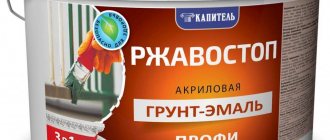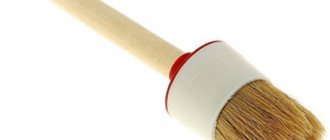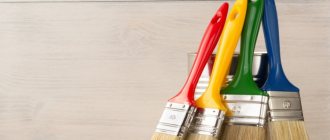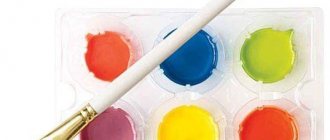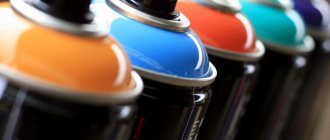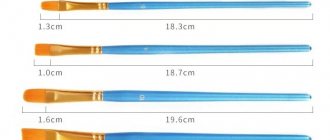A paint brush is a tool that is most widely used in all kinds of paint and varnish work. Its production does not require large time and material costs. Before starting work, brushes that have never been used should be soaped and soaked to soften the bristles. The service life of the tool will increase if the bristles are moistened with linseed oil.
Functional tasks of brushes
When choosing brushes, it is advisable to keep in mind their level of functionality. Most often, tools are required to carry out the following work:
- applying glue for high-quality wallpapering;
- painting walls, flooring, doors;
- painting window structures and other premises;
- painting various furniture;
- painting benches installed in the garden.
In each case, brushes are needed for certain tasks, so when choosing, it is important to determine the degree of functionality and technical features of the painting tools.
Only if the right choice is made will there be a chance to evaluate the worthy performance of the work.
Working part size
Paint brushes are divided according to the size of the working part:
- The smallest diameter is 25 mm. Such a tool is used for preparing other elements or painting works.
- Workpieces with a working part circumference of 38 mm are used for work with round-shaped objects, for example, cornices or baseboards.
- Pencils with a diameter of 50 mm are well suited for processing door slots, window frames and other structures of small width.
- Tools with sizes ranging from 63 to 75 mm are considered universal and are most often used for paving walls and other wide structures.
The largest pens have a diameter of 100 mm. Their vikoristannaya is more suitable for overall surfaces, for example, walls or external walls.
A brief overview of paint brushes
Different models are focused on a specific area of work. Taking into account such parameters guarantees the opportunity to make a worthy choice and perform quality work. Which tools are best? The answer to the question will be a brief overview based on classification.
Types of paint brushes are one of the most important questions that it is advisable to ask before carrying out the planned work.
Brush - handbrake
The main differences: large sizes, high-quality bristles, attached to a short handle. For maximum reliability, a metal rim is used.
It is important to note the possibility of tying individual fibers with twine, which creates a basis for convenient, complete work, regardless of what is recommended to paint the surface with.
Trimming brushes
Models called trims are used in situations where the painted surface must be rough and matte at the same time.
The most important rule: in any circumstances, the brush used must remain clean, so it is recommended to regularly moisten it, eliminating excess paint particles.
It is best to work according to the following scheme: careful and most targeted blows on the surface to be painted, because only in this case is the quality of the planned work guaranteed.
Maklovitz brush
The maklovitsa brush is made in round and rectangular shapes. In the first case, the diameter is 170 millimeters, in the second case – 200. Among the advantages it should be noted:
- maximum level of performance;
- the ability to perform painting work with the highest level of quality.
Maklovitsa brushes are best suited only for applying aqueous solutions.
Flying brush
Flying brushes are made in a round shape. Such models are recommended for almost all types of work, because they are distinguished, first of all, by a high level of functionality.
Moreover, there is the possibility of high-quality processing of a large area.
Swing brushes can be used even for those areas that are difficult to reach, and the additional use of long sticks is recommended.
File brushes
Panel models are made in the form of round and flat tassels. The diameter cannot exceed 18 millimeters.
It is advisable to use file brushes when drawing straight stripes and narrow lines during finishing work.
Radiator brush
Such models have a special design that is ideal for high-quality processing of hard-to-reach places.
It is assumed that batteries and other similar hard-to-reach areas can be successfully painted.
Kinds
Products differ in design, length, shape, and type of pile.
Fly KM
Made from natural fiber and nylon. Synthetic content up to 30%. The bristles can withstand temperature changes, contact with aggressive solvents, and hot water.
Description:
- Round working part with fiber length up to 18 cm.
- d: 60-65 mm.
- Purpose: painting, whitewashing, washing large areas.
When dyeing, the bristles bend a little, but quickly return to their original shape - this is a marker of the quality of the brushes.
Maklovitsa KMA
Base – 50% horsehair, 50% synthetic. The tool evenly applies a layer of paint to any type of substrate.
Description:
- Rectangular, square, round shape.
- Bunch length: round – 10 cm, rectangular – up to 8 cm.
- d: 12-17 cm/width: up to 20 cm.
- Purpose: painting water-based paints, applying adhesives, primers.
Expert opinion
Torsunov Pavel Maksimovich
Maklovitsa work over large areas. A high-performance tool does not require fluting (additional alignment).
Handbrake KR, KRS, KRO
Products are round in shape with a working part diameter of 2.5-7 cm. The base is horsehair, bristles.
It is attached to a short handle with a thick metal clip. Used for small areas, for painting pipes, frames, priming. Tools with adhesive fastening of the pile do not work with whitewash or adhesive compositions. Recommended for slow-drying primers and solvent-free paints. The beam, fixed with epoxy resin, is compatible with all types of paintwork materials. These are handbrake handles with increased resistance to aggressive components.
Classification by beam shape:
- KRO – oval.
- KR - round.
- The KRS is round, tapering into a cone.
The center of the handbrake is empty - it holds the material and evenly releases it to the surface.
Panel KFK
A small tool with a diameter of the ink part of 6-18 mm. The bundle is coarse pork bristles, fixed in a metal clip. Purpose – painting hard-to-reach areas, outlining stripes, contours, working on small objects. Used for a harmonious transition of different colors.
Flat gearbox
Synthetic models with tapered bristles. Retains original shape in use. Suitable for using paints diluted with water, varnishes, and primers. Holds the material on the inner and outer parts of artificial fibers, ensuring uniform dyeing. Size range: 35-100 mm.
Fluted CF
A flat, thin brush leaves a clean, even layer.
Used against drips and unsuccessful strokes left after painting. Works independently when applying a glossy finish. A short-tuft flake applies glaze paints in a decorative finish. Description:
- Pile length: 2.5-10.0 cm.
- Thickness: 9-18 mm.
- Material: badger hair, bristles.
Radiator
Narrow, flat-shaped products with a curved handle. Purpose – applying paint to seams, bends, hard-to-reach areas, sectional structures. Models with a wide working part are intended for exterior finishing.
Trimming brush ShchT
The rigid model is formed by semi-spine bristles. Captures more paint and applies it evenly to the substrate. Purpose - finishing a fresh layer, eliminating unevenness, creating roughness. For use on painted substrates only.
The instrument requires care; a clean bun provides a decorative effect. Painting with trimming requires skill: the paint is applied in precise single strokes.
Special
Necessary for certain types of finishing operations.
Types:
- Edge finishing – finishing of edges and edges.
- Fan - for practicing wide lines.
- Textured – for decorative finishing.
- With beveled pile , dotted with a pointed cone-shaped tuft - processing of window frames.
Brush Bundle Shape
A modern brush and paint should interact as clearly and accurately as possible. For uniform painting of walls, it is recommended to choose models with a beam of a suitable shape. Two broad directions are offered:
- Flat models are the most popular even among professional painters. If the instrument is made of acrylic materials, even greater elasticity and maximum ease of use of liquid, thick compositions are expected. It is assumed that it is possible to successfully paint wide and narrow surfaces of the house, because the width of the bristles determines everything. When choosing flat acrylic brushes, you can count on guaranteed high-quality accumulation of paint with its subsequent easy release to the desired surface.
- Special models are made in a round shape. If a flat brush becomes uncomfortable, a round tool is recommended. The ideal option is to paint a U-shaped profile or work with hard-to-reach areas in the house. The possibility of successful painting of window frames is guaranteed. However, such brush models require strong pressure.
Expert advice
What type of paint brush do you use most often?
FlatRound
Wash new or unused instruments with soapy water. This will remove broken bristles and dust. After cleaning, squeeze and dry the bunch.
What to do before painting:
- Soak - the fiber will absorb moisture and increase in volume. The brush will apply the material smoothly and evenly.
- Develop - the working part will take the correct cone shape. Dip it in paint and paint the brick or concrete area.
What to do after:
- Clean the product with kerosene, then with soapy water. Alternate until the water runs clear.
- Soda cleanses piles well - immerse the bundle in the solution for 2-3 hours, rinse with warm water, and dry.
- After washing, hang and dry the instrument.
When storing the brush, wrap it in thin parchment paper - it will not lose its softness.
Dimensions
Modern brush sizes allow you to divide tools into narrow, medium, and wide thickness options:
- Narrow brushes have a width of one to three centimeters. High-quality processing of thin surface elements, pipes and even hard-to-reach corners is expected. Moreover, narrow acrylic brushes allow you to successfully apply decorative images made in the form of trees.
- Medium-sized brushes have a working width of 3.5 – 6 centimeters. The main task is painting doors, furniture and other household items.
- Wide tools are ideal for painting floors, ceilings, and walls. The painting brush has a beam up to 10 centimeters wide.
This difference in width allows you to choose the most suitable model for the work ahead.
Pile materials
The pile of painting pens is divided into three types:
- Natural. Most suitable for working with oil-based paints, linseed oil, and various types of varnishes. The natural pile is soft, picks up quickly and washes out varnish-based materials well. When in contact with water, the bristles become coarse, lose strength and badly scratch the surface. It is not advisable to use a tool with natural bristles together with water-based cleaning agents.
- Synthetic. It becomes congealed when the surface is coated with vicorized water-dispersed varnish-based agents. Synthetic bristles improve wear resistance and allow you to scrub smooth surfaces. The individual fibers are good at absorbing varnish not only from the outer surface, but also from the inner surface - right up to the very middle of the bunch. Such power allows you to increase productivity and significantly save time.
- Mixed. Suitable for all types of pharmaceutical warehouses - both oil-based and water-based, it absorbs the farb well and has high wear resistance. Pencils with mixed bristles use the best parts of tools with piece and natural bristles, which will be scrubbed with great scrubbing.
Before working, any type of brushes must be soaked in a sliver of cotton wool, allowed to dry a little, and then coated with flaxseed oil. This is necessary to soften the pile.
How to choose the right brush?
Choosing a tool for painting work is an important stage that needs to be handled as successfully as possible. Knowing what requirements are taken into account helps you make worthwhile choices.
Technical parameters and functionality are always determined by the following aspect: what modern brushes for painting are made of.
Recommendations:
- For painting the main area, only the swing type of tool is suitable;
- Treating areas that are not easy to access requires the use of a synthetic panel brush. This model is made in a round shape.
When choosing a brush for painting, it is advisable to take into account the type of material for the brush handle. A wooden handle will be light and cheap, but a plastic handle will certainly please you:
- durability;
- resistance to various influence factors;
- quick paint removal.
If you dream of becoming the owner of a durable painting tool, it is advisable to choose a product: Firstly, it involves fixing a bunch of brass parts. Secondly, if high-quality brass is used, the risk of corrosion is completely eliminated.
Types of bristles
Natural fiber bristles are ideal for painting work; they hold the composition well, applying it in an even layer. It feels a little rough to the touch, which allows it to absorb more paint. This is what distinguishes it from artificial (nylon) hairs.
Bristles made of synthetic materials consist of polymers and have a small thickness. Different types of modern polymers allow you to achieve the desired rigidity. Nylon polyester bristles are perfect for water-intensive paints; their hairs do not absorb the paint material; nylon repels moisture and retains its original structure. In addition, nylon is better suited for painting timber without leaving lint on it.
USEFUL INFORMATION: Which windows are better: plastic or wooden?
Mixed bristles are usually considered to be those that consist of natural and synthetic fibers (usually nylon). This approach improves the elasticity and wear resistance of the paint brush.
Brush care rules
When choosing even the best brush made of metal or other material, you need to remember that it will only be designed to work with certain materials. For example, it is ideal to paint acrylic materials with synthetics, while it is advisable to apply alkyd and oil paints with a natural brush.
It is equally important to keep the brush clean, as the paint will quickly destroy its bristles. Moreover, you can store the brush only after thorough washing.
Peculiarities
The production of paint brushes is subject to GOST 10597-87; according to KOSGU, these products are classified as tangible assets. According to these technical standards, a paint brush includes several elements.
The main functional component is the bristles. It is fixed in the clip with an adhesive composition, and the clip, together with the pile, is attached to the handle. The bristles of the brush in the holder are separated by several inserts; they form a working chamber space for varnishes and paints.
The number of liners and their size directly depend on the dimensions of the tool and have a significant impact on the overall quality of painting. For example, if the number of liners is disproportionate to the size of the brush itself, then the density of the pile will be low. Accordingly, the applied coating will adhere worse to the base, and the paint-exchange parameters of the tool will be significantly reduced. Inserts are made of plastic or wood. Paints often come into contact with water, wood is deformed in such conditions, so professional workers choose the first type of tools.
The bristles, liners and clip are placed on the adhesive solution. The pile is attached to the entire height of the liner. The service life of the painting tool directly depends on the characteristics of the glue used: budget models use cheap adhesive solutions, expensive ones use epoxy glue.

